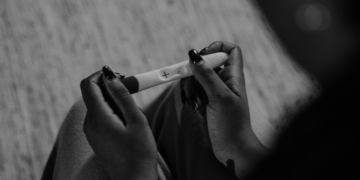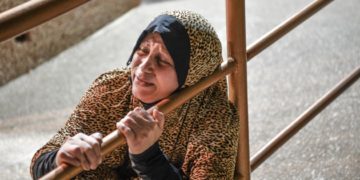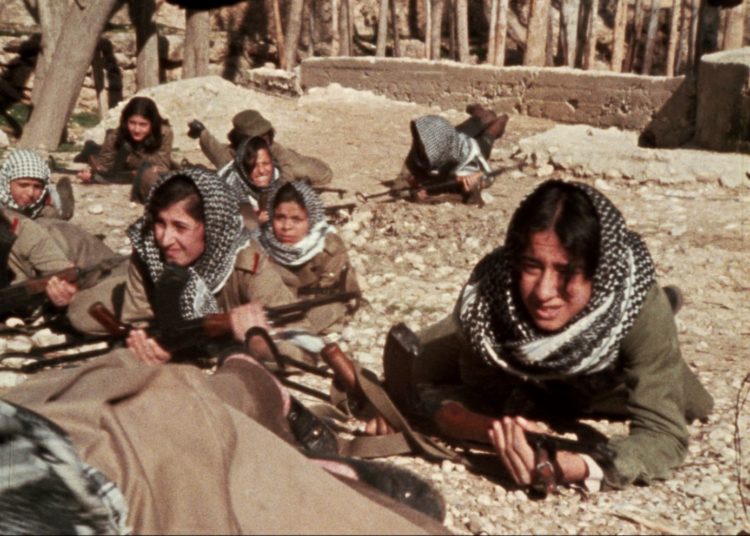This post is also available in: Français (French) العربية (Arabic)
Photo by Amel Hadjaj. Homeless women of Algiers.
The latest available data, covering the period from January 1 to August 6, 2023, indicates that the number of unhoused people in the wilaya of Algiers has been recorded at 7,063. Among them, 596 are women and 314 minors, according to the Directorate of Social Action and Solidarity (DASS). However, walking the streets of Algiers several nights in a row is enough to observe that there are almost just as many unhoused women as there are men. Moreover, in light of the testimonies collected, we have noted that the reasons for being on the streets and ensuing living conditions vary profoundly according to the gender of these vulnerable people. Unlike most men, unhoused women are accompanied by young children, often toddlers or teenagers.
S.F. lives on cardboard boxes spread out near restaurants on a busy alleyway in Bir Mourad Raïs. Dressed in a worn black djelabba and winter shoes, she faces the harshness of her daily situation with silent dignity. Around her, the smell of food and noise of passersby fill the air as she tries to blend into the anonymity of the place, where life goes on, despite everything. She tells me that women and girls stay together to protect each other, while boys, as soon as they grow up, prefer to become independent.
It is striking to note that more than 70% of unhoused people came to Algiers from other wilayas and survive mainly through begging, according to DASS. These alarming figures are only the visible part of a larger problem. They reveal a deep malaise and a glaring lack of support.
Women, the first victims of violence and abandonment
Unhoused women are often the first victims of violence. Many flee abusive or destructive family environments. S.F., who is now 38, had no other refuge but the street. “I often stay near restaurants so I can receive donations from wealthy customers. But I also sometimes sleep near police stations or mosques, to avoid being attacked. Wherever I am, though, fear never leaves me,” she shares.

In 2020, a year that was marked by the pandemic, the Directorate General for National Security (DGSN) recorded 5,835 cases of violence against women and 43 femicides, according to Feminicides-dz. That same year, S.F., unemployed and having interrupted her studies in her final year of high school, found herself on the street for the first time, fleeing the violence of her husband, with whom she was confined. “I didn’t expect that no one would open their door to me that night,” she recalls. “Sleeping outside was terrifying, but paradoxically, it was the calmest I’d had all week. My husband had tried to strangle me three times, repeating again and again that he was going to kill me.” After spending two nights on the streets, consumed by guilt over her three children, the young woman returned to her ex-husband. It wasn’t until 2023 that she found the strength to divorce, no longer able to bear the blows he inflicted on their son every day. “It was the hardest decision of my life,” she confides, distraught. Like her, many women find themselves on the streets after trying in vain to find a solution to this invisible violence, leaving behind a painful past and an uncertain future.
Motherhood on the street: a double punishment

L.M., an unhoused woman we met with several times, lives with her two daughters, aged 13 and 11, in Bab El Oued, not far from the covered market. Her 16-year-old son became uncontrollable—“I had to let him go. He wanted to be independent, and I think it’s less risky for him,” she says, resigned. This tragic decision illustrates the double punishment these mothers face: having to survive on the streets, all while protecting their children from an uncertain future. Most minors, like L.M.’s two daughters, have no choice but to beg to support themselves, remaining cloistered in a world without hope.
L.M., sitting in a dark corner of this dilapidated street, blends into the dusty and rough décor of her surroundings. The street corner is framed by crumbling walls strewn with graffiti and old torn posters, remnants of past legislative elections. The air is heavy, laden with the stench of damp accumulated garbage. There are overflowing trash cans nearby. They attract stray cats that rummage silently through the heaps. The distant sound of traffic and the murmurs of passersby echo here, where she sits, almost invisible to the eyes of the world, lost in the indifference of this street.
Just like S.F., L.M. bears the heavy burden of an ex-husband who ignores post-divorce court orders regarding child support and housing. The amounts set by the courts are often insufficient, and many men regularly refuse to pay the sums due. Landlords often demand a year’s rent in advance. L.M., who will soon be 45, regrets having waited until 2022 to divorce. “My ex-husband was against the idea of me working. This closed a lot of doors for me,” she explains. Two months ago, unable to continue paying her rent, she was evicted by her landlady. She couldn’t bear the conditions of the SAMU Social, where comings and goings are extremely controlled and where she risks being separated from her children. So she preferred to go to the street.
The reasons for being on the streets and ensuing living conditions vary profoundly according to the gender of these vulnerable people.
Her biggest worry is getting her two daughters back in school, which she does not know how she will afford. Her son dropped out of school last year. S.F. also shares this concern. She highlights the difficulties of living without a fixed address. “I don’t know how to receive mail. I even had to change cities to escape people’s gaze, this social guilt that eats away at me,” she adds, sadly. She also talks about feeling socially rejected, the difficulty she has in starting cumbersome procedures to try to benefit from the Ministry of Justice’s food fund or minimum income for unemployed people—aid that, according to her, does not account for unhoused women. These women, already under the burden of precariousness, must face the additional obstacles of bureaucracy, social isolation, and constant fear for the future of their children.
Every time I go to visit them, I walk a bit more slowly to watch how passersby react, what the attitude of the neighboring merchants is. Children beg mainly from drivers who are parking, while male beggars mostly address women. Most passersby look away and change their route to avoid these groups of unhoused people, who, though invisible, are omnipresent in the city: on the sidewalks, on the corners of buildings, in front of old colonial facades, in hidden alleys. Sometimes, these people are exclusively Algerian. Sometimes they're all sub-Saharan migrants. It’s rare to see the two groups coexist in the same area.
A glaring lack of adequate and adapted reception facilities
Despite there being 369 reception facilities across the country that cover various categories (early childhood, the elderly, the unhoused, cancer patients, SAMU Social, and youth centers), the facilities available for the unhoused only offer them nighttime accommodation. Every morning, they are forced to leave the premises, left to their own devices for the day. Most unhoused people refuse the help offered, preferring to return to the streets. According to the director of social services in the wilaya of Algiers, many refuse to go to the Gué de Constantine reception center because of the precarious conditions or the geographical distance. “The street is sometimes less humiliating than the reception facilities, where places are limited and living conditions are degrading,” an unhoused woman in her sixties, whom I met outside a mosque near the Algiers square, explains to me.
In Algiers, the SAMU Social is supposed to play a key role in caring for the unhoused, but it cannot face the scale of the phenomenon. Outside the capital, the situation is even more critical. Local initiatives are sorely lacking, and associations, despite their good will, struggle to meet the massive needs of these women and children.

Kamel H., a young student volunteering with a charity, whom I met while he was distributing hot meals to the unhoused population of Algiers in Bab El Oued, was wary when he saw me using a recorder with the unhoused women. Once reassured of their consent, he agreed to share his point of view. The association he volunteers for mainly provides hot meals, clothes, and blankets to the unhoused, especially as winter approaches. Last December, he attended a meeting where the Wali of Algiers Abdennour Rabehi called for emergency measures to improve care for the unhoused. Among the main measures are the extension of social services’ night-time outings and the increase in the number of beds in hospitals for psychiatric patients. But although these initiatives reflect an awareness of the seriousness of the situation, Kamel H. remains skeptical about the actual impact they will have. He deems them insufficient, given the scale of the issue.
Disappointed, the young volunteer also shared an altogether traditionalist vision with me. “Unhoused women should endure more, like our grandmothers, rather than choose the streets where they risk losing their honor,” he says, referring to the testimonies of rape and prostitution that he’s heard. He also believes that many women are not on the street out of necessity but are rather exploited by begging networks that feed on their distress without offering them any real help.
But these are really lives on hold, with an uncertain future—a far cry from this patriarchal vision. For these women, the street is place of survival, but it is also a lawless space where they are just invisible silhouettes in an urban landscape whose inhabitants prefer to look away. Despite the alarming figures from the Ministry of National Solidarity, Family, and the Status of Women, which estimates that there are more than 120,000 unhoused people in Algeria, efforts to reintegrate them into society remain insignificant. Minister Kaoutar Krikou has often stressed the importance of reintegrating unhoused women into their family environments, but this is based off the assumption that this environment still exists, while for many of them, the street was the only way out of a violent, even totally destructive family environment. So any prospect of return is illusory.
The right to housing: constitutional but inaccessible
During my discussions with S.F. on the first day that she agreed to speak with me after several attempts, I was particularly upset and uncomfortable, afraid of twisting the knife in the wound without being able to offer her any help. At first, she hesitated and asked me to come back later, several times—implying her refusal to be exploited. Her argumentation was captivating: her gaze intense, she kept telling me to come back until one day she finally spotted me from afar and waved me to her.
The street is a lawless space where they are invisible silhouettes in an urban landscape whose inhabitants prefer to look away.
That day, another woman, who was visibly depressed, insistently tried to approach me. She spoke to me violently and gave me orders, as if I were able to immediately resolve the problematic situation she was in. S.F. explained to me that this woman had been on the streets for years, after she gradually started to lose her mind. A former retired employee, she went through a traumatic divorce that she never got over, though her retirement could have saved her from the streets. In fact, she had financed the construction of her house on her own, but she’d naively agreed to put it in her ex-husband’s name. He then got remarried to a younger woman and eventually threw her out. Her adult, married son was unable to help her, abandoning her to her sad fate.
Housing is often a determining factor when it comes to women’s precariousness—be it due to inheritance, divorce, or bureaucratic obstacles that complicate their reintegration once they are put on the street. Many women find themselves trapped in a spiral where every attempt to get back on their feet is made more difficult by a system that marginalizes them. For years, feminists have been calling for specific measures to guarantee women secure access to housing and to protect this right so that no woman can be put out on the street by a family member or ex-husband.
It cannot be denied that the reality exposing women to the streets is closely linked to their gender and all the discrimination they suffer. Among the ten women I spoke to, two had become single mothers at a young age: family rejection made them end up on the street. In Algeria, women can declare their children born out of wedlock in their name, but social practices and the exclusion of these women can render them so precarious they find themselves alone and unhoused.
Thus the streets of Algiers reveal a poignant and often-ignored reality: that of unhoused women, the victims of systemic marginalization and exacerbated precariousness. The lack of adequate reception facilities and authorities’ insufficient response highlight the urgent need for profound reform to offer these women real protection and opportunities for reintegration and to allow them to recover their dignity.
This investigation was carried out with the support of the Tunis Office of the Rosa Luxemburg Foundation.































